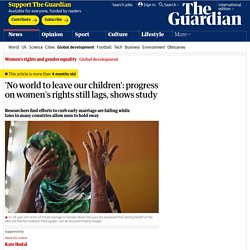

'No world to leave our children’: progress on women's rights still lags, shows study. Progress on women’s rights has been far slower than expected across the world as a report shows underage marriage rates have barely come down this decade, while dozens of nations still legally prioritise men.

Forty-one countries recognise only a man to be the head of the household; 27 countries still require that women obey their husbands by law; and 24 countries require women to have the permission of their husband or a legal guardian (such as a brother or father) in order to work. One in six girls worldwide is still married before turning 18, despite the introduction of legislation increasing the legal age of marriage in more countries than ever, according to a new global gender index. The numbers have decreased so slowly since 2012 that global advisers warn it could take a century before child marriage is eradicated for good. Women still face legal restrictions over unwanted pregnancies in 119 countries, with only two countries having decriminalised abortion since 2012. More than 20,000 underage girls marry illegally each day, claims study. Every day, around the world, more than 20,000 children are getting married, underage and illegally.

New statistics show that in countries where there are laws restricting the practice, 7.5 million girls every year are married below the minimum age permitted, according to analysis by the World Bank and Save the Children. One in every three girls in the developing world marry before the age of 18. Child brides often drop out of school, due to domestic responsibilities, pregnancy, parenting and social pressure and some governments, such as Tanzania, prevent married or pregnant girls from attending school.
The past two years have brought some progress. 10 Important Examples of Gender Inequality Happening Today. The fight for gender equality is an ongoing struggle for men and women throughout the world.

Many aspects of gender inequality are events that men will never face, but that constantly shape women’s mental health and opportunities. Listed here are the top 10 examples of gender inequality found in the daily lives of women across the globe. 10 Extreme Examples of Gender Inequality. The human rights of women throughout the Middle East and North Africa are systematically denied by each of the countries in the region, despite the diversity of their political systems.

Many governments routinely suppress civil society by restricting freedom of the press, expression, and assembly. These restrictions adversely affect both men and women; however, women are subject to a host of additional gender-specific human rights violations. For example, family, penal, and citizenship laws throughout the region relegate women to a subordinate status compared to their male counterparts.
This legal discrimination undermines women’s full personhood and equal participation in society and puts women at an increased risk for violence. Gender Inequality Runs Rampant in India. In New Delhi, there are 13 times more toilets for men than there are for women.

Specifically, there are 3,712 male public toilets, and a mere 269 female toilets. Women sometimes must resort to defecating in the open, which besides the obvious privacy violation, poses a significant risk of rape and violence.
Stories of Hope in Haiti — Concern Worldwide. Loud and proud Lunes Duvil is a quite the character.

Tough as nails, but with an impish grin, she talks loudly and laughs easily. Here on the side of Route 9, everything is loud, as endless trucks, buses, and motorbikes roar past, crashing gears and bouncing through potholes. Known as Route Soleil, it connects the west of Haiti with the north, and serves as the boundary of Cité Soleil — which the internet will tell you is the biggest and poorest urban slum in the Caribbean. “Now, I make more money.” This is where Lunes set up her business 10 years ago, in a cramped metal cabin just a few feet from the passing traffic.
Lunes outside her store on Route 9 at the edge of Cité Soleil Photo: Kieran McConville Lunes is part of an ambitious project to bring new hope and opportunity to an area where that has been in short supply for a long time.
Cape Town: What It's Like to Live Through Water Crisis. Capetonians collect water from the Kalk Bay spring on Feb. 1; at some springs, waits can drag on for hours.

Mikhael Subotzky and Johnny Miller for TIME What It’s Like to Live Through Cape Town’s Massive Water Crisis By ARYN BAKER Photographs by MIKHAEL SUBOTZKY and JOHNNY MILLER for TIME I knew we were in trouble when I found myself Googling dry composting toilets. That was on Feb. 1, just after the mayor’s office here in Cape Town announced new water restrictions.
According to current projections, Cape Town will run out of water in a matter of months. People queue to buy water at a grocery store in Milnerton, a suburb of Cape Town, on Feb. 3. Millions of people around the world live without sufficient access to water. Cape Town: What It's Like to Live Through Water Crisis. Cape Town: What It's Like to Live Through Water Crisis. Featured.
TGA Pupil Questionnaire. Migration. Nature Conservancy. Portraits of Innovation: Exploring Innovative Models for Teaching Today's Students. Contributing Teacher: Shawn Thomas Name of Project: Global Issues Content Area: 7th Grade Social Studies District Goal Strategies Used: An open ended question that requires students to think critically about an engaging topicMultiple pathways to demonstrate learningOpportunities for students to share their thinking and collaborate with othersWork shared with an audience beyond the teacher and the classroomTechnology integration that enhances learning at the Modification and/or Redefinition level (SAMR) Project Description: The project revolved around the question: What steps can we take as middle school students to inspire others to take action?

This project would not be possible without 1:1 technology. How did students benefit from this approach? Students were able to make a real impact in their community and make real connections between their lives and bigger global issues. School Pen Pals and Key Pals.